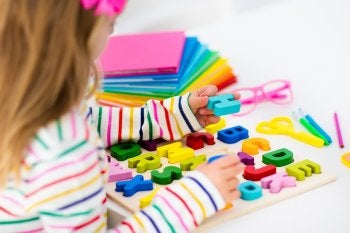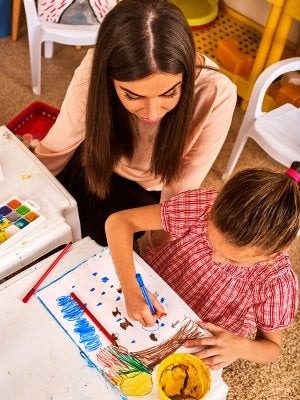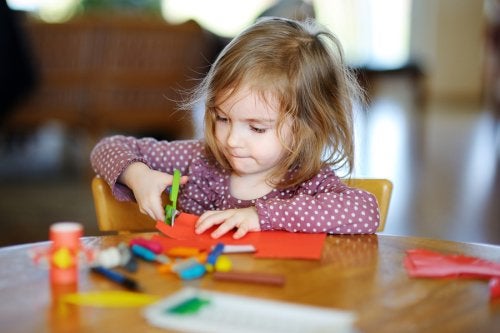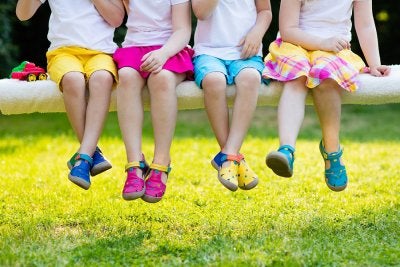-
Letter Recognition Tips for Parents of Pre-K Kids
Is your pre-k child being introduced to the alphabet in school? If so, then as a parent, you’re probably eager to support your student along his path to reading literacy. If you’re wondering what you can do to help your child in pre-kindergarten in Pembroke Pines with letter recognition, then read on for some tips to try.
Focus on His Favorites
When it comes to helping your pre-k student enjoy the process of learning how to recognize letters, starting with the letters that spell some of his favorite words can be a great strategy for sparking his enthusiasm. Many parents find that their child’s name is a good place to begin. Other words to consider focusing on include his favorite color, food, activity, and animal.
Turn Letters into Artwork
Making letters into something more artistic and tangible is another way to engage your child in the letter recognition learning process, and one way to do this is to turn letter recognition practice into an art activity. So, consider bringing out the finger paint and paper and letting your student draw the letters that he is learning.
Integrate Learning into Daily Life
Helping your child with letter recognition outside of school does not require that you set up special activities. After all, there are letters all around your home and community. Because of this, you can turn everyday tasks like reading the newspaper in the morning or buying food at the grocery store into opportunities to help your child recognize letters.
Try a 3-Dimensional Approach

Finally, one more excellent way to help your pre-kindergarten student with his ability to recognize the letters of the alphabet is to provide him with a 3-dimensional perspective. To do this, simply toss some letter shapes, for example, the magnetized kind that you may have on your refrigerator, into a bag. Try starting out with 4 or 5 of the letters that your student is learning and then encourage him to identify each one while feeling them in the bag instead of looking at them.
-
A First Grader’s Introduction to Social Studies
First grade is an exciting stage for children as they develop critical skills, practice creativity, and master academic basics. If you have a first grader in Pembroke Pines , then one of the subjects that he will explore this year is social studies. Read on to learn a bit about what your first grader might experience in his social studies curriculum.
Rules and Rights
Children in first grade are beginning to exhibit greater independence and take on more responsibility when it comes to caring for themselves and finding things or places. Also, their social studies curriculum can cause them to place more importance on understanding and following classroom rules as they begin to view their classroom as a small society where individuals have their own rights and opinions.
Economy and Transportation
In first grade, kids are introduced to concepts of economy, such as goods and services, buying and selling, and consumers and producers, so do not be surprised if your student sets up a lemonade stand in your living room or attempts to barter for something he wants. In first grade, your student will also study modes of transportation and how they are used.
Geography and Maps
You can expect to see maps and globes when you enter a first grade classroom. Children at this grade level are introduced to things such as the different continents of the world, maps and how to interpret them, and cardinal directions.

History and Culture
At this stage in their development, children understand the concepts of past, present, and future, and as part of their social studies curriculum, first graders explore topics like important events in United States history, symbols and their meanings, national holidays, and other cultures and time periods. These areas of learning may prompt your first grader to compare your family to others and point out examples of diversity in your community as he begins to spot differences in people and groups.
-
Your Child’s Curiosity-Driven Education
From “Why is the sky blue?” to “How do black holes work?” your child’s curiosity over the years will drive his or her education. Humans are innately curious, and it’s this trait that propels them to achieve remarkable accomplishments. Even before your child can speak, he or she curiously explores the surrounding world by touching, tasting, and dropping objects over and over again. It’s why early childhood learning centers in Pembroke Pines give young children the freedom to explore the classroom. By nurturing your child’s curiosity from his or her early education to adulthood, you’re encouraging the love of learning.
The Value of Curiosity
Few people learn effectively by listening to boring, unengaging lectures. From the 1950s onward, researchers studying the science of learning have found that people learn best when their curiosity is piqued. In other words, curiosity directly fuels academic achievement. But curiosity can also be stifled inadvertently, such as when adults discourage children from asking questions. Since curiosity substantially influences early education, it’s important to nurture it.http://www.ascd.org/publications/educational-leadership/feb13/vol70/num05/the-case-for-curiosity/

An Easy Way to Redirect Creative Energy
Of course, a child’s curiosity can often get him or her into trouble. Finding out how the plumbing works by flushing a toothbrush isn’t a welcome turn of events. You can have the best of both worlds by validating your child’s curiosity and redirecting it to less problematic actions. For instance, if your child wants to know what would happen if he or she dropped an egg on the floor, you could invite him or her to take an egg outdoors and drop it on the ground instead. If your child asks you why walruses have tusks, you could say, “I’m not sure. Let’s look it up and find out!”
The Building of Connections Through Curiosity
You are your child’s first role model, and one of the most valuable lessons you can teach your child is that admitting a lack of knowledge is the first step toward learning. Parents often try to avoid saying, “I don’t know” to their kids. This is understandable, but it also suppresses curiosity. Instead, you can teach your child that it’s okay not to know everything—and that’s why people ask others for information or help. If your child is curious about life on a farm, take him or her to a working farm for a tour, or set up some face time with a relative who milked cows.
-
Help Your Child Create an Illustrated Book
Early education activities are often fun for adults as well as children, as they are typically hands-on, creative exercises. At this young age, children learn best by manipulating physical objects and stimulating the senses. For example, you can help your pre-k student in Pembroke Pines create his or her own illustrated book. For this pre-kindergarten activity, you’ll need about five to 10 sheets of blank paper or colored construction paper. Assemble some assorted markers or crayons, or let your child use finger paints or watercolors.
Ask your child to tell you a story. It could be a list of fun things your child did that day, or what the two of you saw during a walk in the park. If your child was at the early childhood education center, the story could be about what he or she did in the classroom. Write down your child’s story, using a new sheet of paper for each main point. Invite your child to illustrate the pages, and then staple them together. Don’t forget the cover page!

-
See How One Classroom Learns About Empathy
See How One Classroom Learns About Empathy
Your child’s education is a priceless investment in his or her future. Kindergarten schools in Pembroke Pines can help build character and cultivate empathy, while also teaching the basics like kindergarten math. Empathy is intuitive, but it’s also a skill that can be taught. You can see how one classroom in Boston cultivates empathy when you watch this video.
You’ll hear from the kindergarten teacher and a few of her students as they complete an activity called “A Mile in Someone Else’s Moccasins.” Since kids this young have a hard time grasping abstract concepts, this activity is a more direct, concrete way of teaching students to be mindful and respectful of other people’s feelings and perspectives.
-
Here’s Why Fingerplays Benefit Preschoolers
Sometimes, low-tech solutions are best when it comes to activities for preschoolers. Long before young children attended learning centers and worked their way through a preschool curriculum , mothers used lullabies, rhymes, and fingerplays to soothe and engage them. These simple activities are still a staple in preschools in Pembroke Pines, as they offer a wide range of benefits for young learners.

Communication
One of a preschool teacher’s jobs is to help children fine-tune their communication skills, language comprehension, and vocabulary. Fingerplays fit all of these requirements. These simple activities capture the children’s attention, and encourage them to focus on what the teacher is saying or singing. Children practice following directions by copying the teacher’s movements, and singing along. And since fingerplays can involve a wide range of topics, they’re an effective tool for reinforcing vocabulary words.
Engagement
Early childhood education research reveals that engaging a child’s senses is a pathway to learning. Fingerplays do much more than just capture an active child’s attention. They stimulate his or her auditory, visual, and tactile senses. Fingerplays are also a form of kinesthetic learning, as the students are encouraged to enjoy movement while participating in them.
Imagination
Many preschool activities involve manipulating physical learning materials. Fingerplays are hands-on too, but in a different way. They encourage children to use their imagination to visualize the story expressed in the rhyme or song. For instance, the accompanying fingerplay to the Itsy Bitsy Spider rhyme uses innovative movements to mimic a spider climbing up the waterspout, and then being washed away by the rain.
Motor Skills
At such a young age, children must work hard to master their fine motor skills. Even before they master the act of gripping a pencil, kids can build muscle strength in their hands and fingers, and hand-eye coordination by mimicking fingerplays. Some fingerplays also engage gross motor skills, such as by reaching the arms up over the head.
Examples
Consider learning some of the fingerplays your child is doing in school. One common example is the apple tree fingerplay. Here are the rhymes and their accompanying movements:
- Way up high in the apple tree (Point upward)
- Five red apples looked at me (Show five fingers)
- I shook that tree as hard as I could (Use both hands, pretend to shake a tree)
- Down came an apple (Wiggle fingers while moving the hands downward)
- Mmm, it was good (Rub your stomach)
You can then repeat the fingerplay with four, three, two, and one apple to start with.
-
Motor Skill Milestones in Pre-K
Kids in pre-K go through an amazing number of transitions that always amaze parents. In particular, kids in this age group reach a number of important milestones with their motor skills. If your child is enrolled in pre-K in Pembroke Pines, keep an eye out for these exciting developmental changes.
Both gross and fine motor skills take a leap in pre-K. In terms of gross motor skills, kids learn to control their running more precisely, including stopping and turning more gracefully. Kids at this age learn to hop on one foot, do somersaults, and bounce, catch, and throw a ball. Parents are also thrilled to discover that their kids can now brush their teeth, comb their hair, and dress themselves without help. Fine motor skill development in pre-K includes learning to print letters, cutting on a line, and using utensils appropriately. Copying shapes, like crosses and squares, also becomes easy.

-
Fun Games That Teach Self-Regulation
One invaluable skill that kids learn in early childhood education is self-regulation. In the classroom, teachers use games to foster this area of child development for better classroom management and so that students get the skills they need to succeed in school as they progress through each grade. Your child’s early childhood education teacher in Pembroke Pines will be happy to discuss the activities he or she uses to teach self-regulation with you. These games are just a few of the fun ways teachers help kids learn the all-important skill of self-regulation and self-control.

Red Light, Purple Light
Many students are familiar with the game red light, green light, but changing the colors makes students adapt while practicing their color recognition. Start by assigning “go” and “stop” meanings to two different colors, and use construction paper in those colors to indicate when students should move and when they should stop. Once the children have automated their responses to those colors, change to two different colors and repeat the activity. This game forces students to concentrate and regulate how they respond to cues.
Simon Says
Simon Says is a classic game that offers many opportunities to practice self-regulation. To succeed, students must listen, concentrate, modify their movements, and follow directions. Giving students each a chance to be Simon further increases the chances to work on self-regulation.
Think or Say
Emotional self-regulation is also an important part of early childhood education. The Think or Say activity makes children think about how they are feeling and is especially ideal for helping kids through their tattling stages. Teachers can introduce many different scenarios and ask the class whether they should say what they are thinking or keep it to themselves. The scenarios can range from dealing with hurt feelings from a classmate to what to do if they see a classmate who is not following directions. Teachers can adapt the scenarios to make them relevant to things that are happening in the classroom.
-
Library Do’s and Don’ts for Kids
Visiting the library is a fun way to encourage your kids to love to read. When your child is working on Kindergarten reading in Pembroke Pines , going to the library to find books to supplement what he or she is learning in the classroom is a perfect way to show your child the world of reading for pleasure.
Help your kindergarten-age child get the most from his or her library experience by teaching the rules in this video before you go. The library is not the place for running or loud noises. Show your child how to treat books with respect and only handle them with clean hands. The library can become a favorite family destination and a good resource for supporting Kindergarten reading once your child learns the rules.
-
Raising a Young Scientist
There are many ways to encourage your child to enjoy science and learning about the world around her. Speak with her Pembroke Pines pre-kindergarten teachers about different educational tactics, and speak with your child about different ways she would like to learn. Perform experiments with each other and have fun researching different topics. Read on for more information about how to raise a young scientist.

Encourage Curiosity
Children are naturally curious and always have questions about how the world works. This natural curiosity is a great gift for your child, so encourage it however and whenever you can. Answer your child’s questions and engage in a dialogue to begin developing her critical thinking skills. If you do not know the answer to a question, then take the opportunity to research together. Ask her pre-k teacher, check out library books, and search websites on the internet. This experience will show your child the value of research and learning.
Speak with Eloquence
Many people speak down to children, because they believe children will not or should not understand an adult conversation. However, children are much smarter than some adults give them credit for, and they can understand complicated situations in much simpler terms. You can help your child foster her communication skills early by speaking to her with eloquence. Treat her like an equal and do not shy away from large words or complicated terms.
Engage in Experiments
There are so many science experiments that can be done at home or in your child’s pre-kindergarten class. These activities are fun and engaging, and you can create a dialogue about how different scientific elements work. For example, you can grab a variety of items and see which ones will float or sink in a bucket of water. Have your child guess which object will float or sink and have her place each one in the water. This can be a wet and silly experiment that will also teach your child more about water and how it reacts to everyday objects.
RECENT POSTS
categories
- Uncategorized
- Early Learning Center
- Pre-K
- Children
- Child Care Center
- Preschooler
- Preschool Blog Category | Tanglewood Academy
- Preschool Lunch
- Tanglewood Academy
- After-School Program
- Toddler School
- Early Childhood Education
- preschool activities
- pre-kindergarten
- childhood education
- pre-kindergarten programs
- Children’s education
- enrichment opportunities
- Kindergarten
- Nurturing Education Environment
- Toddler Care
- Child Separation Anxiety
- Toddlers
- Summer camp
- summer activities
- VPK
- Voluntary Pre-K
- Outdoor Activities
- Smart Strategies
- Tie Shoes
- Snacks
- Physical Activities
- Education
- Enrichment Activities for Kids
- Early Education Activities
- Preschool Curriculum
- Classroom Learning
- APPLE accreditation
- Language Comprehension
